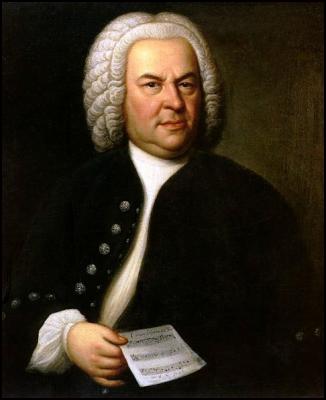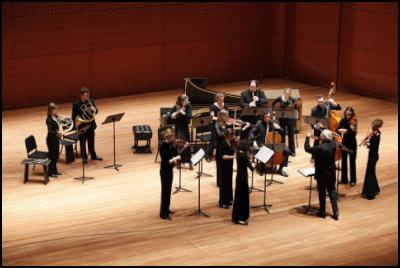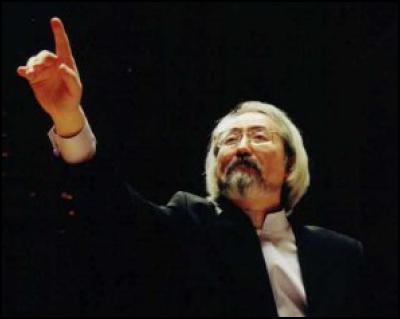Four Old Bach Favourites -
Masaaki Suzuki &
Juilliard415.
By Howard
Davis"The best proof we have that life is good, and therefore that there may perhaps be a God after all, who has our welfare at heart, is that to each of us, on the day we are born, comes the music of Johann Sebastian Bach. It comes as a gift, unearned, unmerited, for free."
- JM Coetzee, Diary of a Bad Year.

As part of Chamber Music New Zealand’s Kaleidoscopes Season, Masaaki Suzuki and the prestigious Juilliard415 ensemble performed superbly-executed renditions of four perennial crowd-pleasers - Bach's Orchestral Suite No 1 in C Major, the Concerto for Two Violins in D Minor, the cantata Ich habe genug, and the Orchestral Suite No 3 in D Major. When we look at contemporary portraits of JS Bach (1685-1750), the heavy jowls, puffy eyes, and sleek smile leave little indication of the state of mind and spirit in which he must have composed - simultaneously grappling with the ignorance and untidiness of his pupils at the Leipzig Thomasschule, supervising the music in four of the city's churches, and supporting an extensive family, including two wives and twenty children (ten of whom died young). We can only speculate how he found the time and energy to write anything at all, so frequent, fertile, and fecund were his copulations.
Nevertheless, Bach was equally prolific as a composer, profoundly enriching pre-established Baroque conventions through his mastery of counterpoint, harmonic, and motivic organisation, and his adaptation of rhythms, forms, and textures from Italy and France. In addition to such well-known works as the Brandenburg Concertos, the Goldberg Variations, the Mass in B MInor, and two Passions, he wrote prodigious amounts of organ music, and over three hundred cantatas, of which approximately two hundred survive. Although his abilities as an organist were highly respected during his lifetime, Bach was not widely recognised as an important composer until the first half of the nineteenth century. He is now considered one of the greatest who ever lived, writing music of pure genius, revered for its technical command, vivacious artistic beauty, and perfervid intellectual depth. Bach's measured, metrical, almost chemically-pure lines are crystalline in their pristine clarity. Listening to them is like inhaling the sal volatile in smelling salts - bracing, refreshing, and enhancing the senses into an augmented appreciation of the magical world around us.
During his Weimar period (1708-17), Bach devoted his attention to the modern genre of the Italian solo concerto, arranging a total of twenty-two concertos by German and foreign composers for piano and organ. After his appointment as the director of the Kohen Court Orchetra, with its fourteen instrumentalists, he composed a number of concertos in which the violin has the dominant part. Out of a total of six violin concertos, only those in A Minor, E Major, and the Concerto for Two Violins, Strings, and Continuo in D minor have been handed down in their present form. Whereas Vivaldi, Torelli, and Albinoni all accentuated the idea of competition between instruments, emphasizing the contrast between the tutti and the solo instrument by means of different thematic constructions and intensity of sound, Bach modified this conception into one firmly based on association.
The Double Violin Concerto is one of Bach's most famous works and considered to be among the best examples of the late Baroque period. It may have been written between 1717 and 1723 when Bach was the Kapellmeister at the court of Anhalt-Köthen, though the work's performance materials for the Ordinaire Concerten that he ran as Director of the Collegium Musicum in Leipzig are dated 1730–31. In addition to the two soloists, the concerto is scored for strings and basso continuo, and is characterized by the subtlety of the relationship between the violins and the rest of the orchestra, using highly expressive forms of fugal imitation and counterpoint. It consists of three movements: Vivace, Largo ma non tanto, and Allegro. The tutti in the second movement employs a continuo function, leaving the two soloists alone to present an initially fugal melodic line, the expressive beauty of which is perhaps unequalled.
One of Bach's principal concerns was to invest his score with a sense of eloquence, which is why he did not limit the conversation to a dialogue between the two solo instruments, but expanded it to include both soloists and the orchestra. In the midst of the frantic sweep of the opening tutti come two imploring solo interjections which the orchestra brusquely brushes aside, but from which the main motif of the two violins is formed. The orchestra's furious opening theme persists throughout the final movement and, by demanding a sautillé bowing technique, Bach achieves a rhetorical effect that resembles jazz in its subtle syncopations and contrasts of mood.

The two Orchestral Suites that opened and closed the performance are equally well-known, but the highlight for me was the Cantata, consummately presented by soprano Rebecca Farley. Originally composed for solo bass for the Feast of the Purification of Mary in 1727, Ich habe genug ('I have enough' or 'I am content') is the most frequently recorded of all Bach's cantatas, with over one hundred complete recordings listed, and many more of individual movements. His version for soprano and obligato flute, transposed from C minor to E minor and scored for bass, oboe, two violins, viola, and basso continuo, retains the deeply spiritual quality of the original. Sadly, the flute part was largely lost, buried in the normally excellent acoustics at Wellington's Michael Fowler Centre, but Ms Farley's filigree phrasing was sharply etched and clearly relished by the audience.
The first movement is an aria, starting with an expressive melody on the flute which is then picked up by the voice with the words Ich habe genug. The beginning upward leap of a minor sixth is reminiscent of the aria Erbarme dich ('Have mercy') in the St Matthew Passion. The first motif is changed to a phrase that appears at the end of three vocal sections. A similar motif begins the middle section on the words Ich hab ihn erblickt ('I have seen him'), turning upwards at the end. Musicologist Klaus Hofmannn has noted a "feeling of serene contentedness with life" in "elegiac tones," while Julian Mincham commented that "Bach encapsulates this experience of peace and acquiescent submission beyond anything that mere words can convey." Mincham also considers the "flowing oboe arabesques", which the singer imitates twice on the word Freude ('joy'), as a "clear indication that their expressive function is to proclaim the Christian's personal bliss, an inextricable element of this important experience of life". The following recitative begins with the same words as the aria, but with a new melody. The middle section stresses the words Laßt uns mit diesem Manne ziehn! ('Let us go with this man,' speaking of following Jesus) by an arioso in which the continuo follows the singer.
The central aria Schlummert ein, ihr matten Augen ('Fall asleep, you weary eyes') has a complex structure - it is not only a da capo aria of three sections framed by a string ritornello, but also repeats the first section in the center of the middle section. Frequent use of pedal points suggests rest and fermatas stop the forward motion, as Mincham clearly describes it: "The frequent pauses, where everything temporarily comes to a standstill, are suggestive of that peaceful closing of life where there is no activity and disorder is a thing of the past". A short secco recitative, Mein Gott! wenn kömmt das schöne: Nun! ('My God! When will the lovely 'now!' come') ends with a downward continuo line, suggesting both taking one's leave and being lowered into the welcoming grave.
The concluding aria is a joyful dance, embracing death as the final fulfillment of desire - Ich freue mich auf meinen Tod ('I am looking forward to my death'). The text implies a sense of elation in the anticipation of death and a longing for it to happen imminently; then, in the middle section, the conviction that it will release us from the misery of the world to which we have been chained. The joyful longing for the hereafter is expressed by agile coloraturas that characterize the entire movement, corresponding to the first in similarity of the scoring, with its obligato instrument, key, and triple time, but played faster and marked vivace. The cantata traces the psychological progression from unease and distress to clarity and confidence, articulating with typical eloquence a sense of spiritual fulfillment in the final loosening of "this mortal coil." It conveys a strictly Lutheran Pietist message - although resigned to a life of hardship on earth, the protagonist is prepared for death's inevitability by her faith, ready whenever her Saviour calls.

Masaaki Suzuki was born in Kobe in 1954 to parents who were both Christians and musicians, and began playing organ professionally at church services at the age of twelve. He earned degrees in composition and organ at the Tokyo National University of Fine Arts and Music, then Soloist Diplomas at Amsterdam's Sweelinck Conservatory, where he studied harpsichord and organ with Ton Koopman and Piet Kee, and improvisation with Klaas Bolt. Suzuki established the Bach Collegium Japan twenty-seven years ago and has produced numerous highly-acclaimed recordings, including Bach's complete choral works, concertos, orchestral suites, and solo works for harpsichord and organ for the Swedish label BIS Records. He has conducted many major orchestras and choruses around the world and is currently Artist-in-Residence at Yale and Director of its Schola Cantorum. He completed the final recording of Bach’s church cantatas last month, an ambitious recording project that took fifteen years to conclude and has resulted in fifty-five CDs. The New York Times noted, “Musicianship is, to be sure, Mr Suzuki’s greatest strength … a subtle ear for color, a keen sense of harmonic direction, and an ability to make phrases breathe and rhythms live." Maestro Suzuki himself has observed, "I didn't choose Bach from other composers - he is the natural result of my life."
With nineteen members, Juilliard415 is one of the largest international ensembles toured by Chamber Music New Zealand. The ensemble includes a soprano soloist, eight violinists, two viola players, two cellists, a double bass player, a flautist, two oboeists, a bassoonist, and a harpsichord player. It is part of the Historical Performance programme of New York's Juilliard School and specializes in early music, providing opportunities for graduate students to perform with some of the most eminent musicians of the early music world. A high profile concert season of opera, orchestral, and chamber music is augmented by a performance-oriented curriculum that fosters an informed understanding of issues unique to period-instrument performance. The ensemble has a reputation for combining youthful exuberance with poise, precision, and a luminous sound.
As expected from musicians of this caliber, they all acquitted themselves admirably, especially in the Double Concerto. They precisely articulated the varied semiquavers in the first movement, eschewing the uniform bowing style usually associated with Bach, who provided extremely specific instructions in his score. Today's ideal of all-pervasive sostenuto phrasing was alien to his contemporaries, for whom every note was required to have its own strength and weakness. The two most important off-the-string bowing techniques for violinists are spiccato and sautillé - and they are often confused. Every note should be played actively in spiccato, with the bow thrown down on the string for each individual note and lifted up again, producing an individual impulse for every tone. In sautillé, however, the task of jumping is left principally to the resilience of the stick. In spiccato the player is active and the bow passive, describing a figure eight in the air, whereas in sautillé the player is passive and the bow active, with the movement of the hand changing to an ellipse and the bow continuing to describe a figure eight around its balance point. A centre of stability appears halfway between the forefinger and the head of the stick, where dynamics can range from pianissimo to mezzo-forte.
In the Double Violin Concerto's slow movement, the orchestra correctly functioned as the continuo, while the twinned violins vied with each other over the heart-achingly beautiful melody - yet the overall sense of line never obscured the detailed phrasing. In the third movement, Bach's demand that each bar should have a different affection is clearly written into the score and the performers dutifully obliged. Historical performance, with close attention paid to authentic instruments and procedures, is a growing part of today’s international music scene. Violist Alana Youssefian says “It seems that very recently more young musicians have decided to specialise in historical performance, and that has brought a fiery energy to the Baroque world. There is still so much music to be explored the historical performance way. There aren’t any limits anymore.” Like many of her colleagues, she also plays modern music - “Almost all of us received master’s degrees in modern performance before deciding to specialise in historical performance. I don’t find switching between the two difficult, but have realised that playing on my historical instrument speaks to me more than my modern instrument.”
Chamber Music New Zealand chief executive Peter Walls considers this tour as a highlight of the 2017 season, noting that Bach wrote these works specifically for students to perform: “Masaaki Suzuki is one of the world’s greatest authorities on Bach and it’s incredibly exciting to have him lead Juilliard415 on this tour … [He] is mirroring Bach’s intentions for these pieces.” The tour also includes Auckland, Hamilton, Hawke’s Bay, New Plymouth, Palmerston North, Nelson, Christchurch, Dunedin, and Invercargill. Rarely are New Zealand audiences privileged to witness such exemplary professionalism and technically proficient playing.



 Prostate Cancer Foundation: Foundation Hails Select Committee Support For Prostate Screening Pilots
Prostate Cancer Foundation: Foundation Hails Select Committee Support For Prostate Screening Pilots Cross Street Music Festival: First Artists Announced For 2025 Cross Street Music Festival
Cross Street Music Festival: First Artists Announced For 2025 Cross Street Music Festival Bowls New Zealand: Lawson And Grantham Qualify To Keep Bowls Three-Peat Hopes Alive
Bowls New Zealand: Lawson And Grantham Qualify To Keep Bowls Three-Peat Hopes Alive Te Whatu Ora Health NZ: Health Warning – Unsafe Recreational Water Quality At South Bay And Peketā Beaches And Kahutara River Upstream Of SH1
Te Whatu Ora Health NZ: Health Warning – Unsafe Recreational Water Quality At South Bay And Peketā Beaches And Kahutara River Upstream Of SH1 Wikimedia Aotearoa NZ: Wikipedian At Large Sets Sights On Banks Peninsula
Wikimedia Aotearoa NZ: Wikipedian At Large Sets Sights On Banks Peninsula Water Safety New Zealand: Don’t Drink And Dive
Water Safety New Zealand: Don’t Drink And Dive